Search results for: 'Römische den'
-
 Römisches Töpfchen
Römisches TöpfchenGeborgen in den Jahren 1966 bis 1981 in Zusammenarbeit mit lokalen Archäologen. Neuss, das römische Novaesium, war eine frühe römische Gründung in der Provinz Germania Inferior und ist somit eine der ältesten Städte Deutschlands.
Price: on request Roman knee brooch
Roman knee broochPrime example of this important and popular type of brooch during the 2nd century.
Price: on request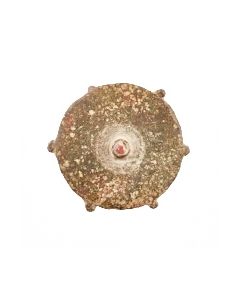 Roman plate brooch found at the Limes
Roman plate brooch found at the LimesAncient brooch with circular plate. Found near the Limes fortifications Pfoerring and Eining in Germany.
Price: on request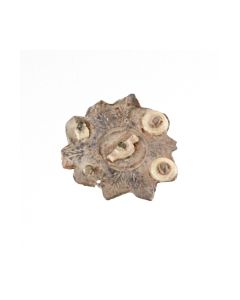 Elaborate Roman plate brooch
Elaborate Roman plate broochTen pointed star form with leaf pattern and decorative buttons. A product of Gaul or Britain dating to the 1st century.
Price: on request Roman fibula
Roman fibulaAncient roman fibula of the kraeftig profilierte fibula type. The piece is a beautiful example of this common type of fibulae during roman imperial times.
Price: on request Roman jar with flat handle from Lopodunum
Roman jar with flat handle from LopodunumPerfectly preserved piece. Found in Ladenburg, Baden-Wuerttemberg, Germany.
Price: on request Roman fibula in lozenge shape
Roman fibula in lozenge shapeAncient brooch in nice condition with remains of the original enamel inlays. Found near the Limes fortifications Pfoerring and Eining in Germany.
Price: on request Rare frog fibula
Rare frog fibulaZoomorphic fibula dating to the Roman Principate. Very nice enameled work. Rare variant of this popular fibula type from Roman Gaul.
Price: on request Roman jar with flat handle from Lopodunum
Roman jar with flat handle from LopodunumNicely preserved piece. Found in Ladenburg, Baden-Wuerttemberg, Germany.
Price: on request Small Roman jar from Lopodunum
Small Roman jar from LopodunumNicely preserved piece. Found in Ladenburg, Baden-Wuerttemberg, Germany.
Price: on request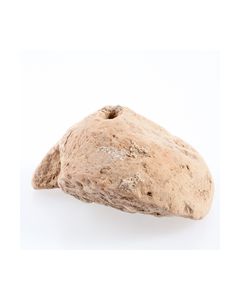 Römisches Gewicht aus Terrakotta
Römisches Gewicht aus TerrakottaTongewicht mit Bohrloch aus römischer Zeit. Provinz Belgica.
Price: on request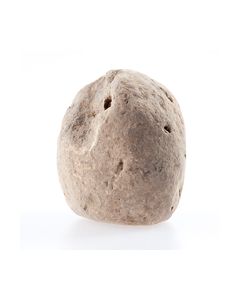 Römisches Gewicht aus Terrakotta
Römisches Gewicht aus TerrakottaTongewicht mit Bohrloch aus römischer Zeit. Provinz Belgica.
Price: on request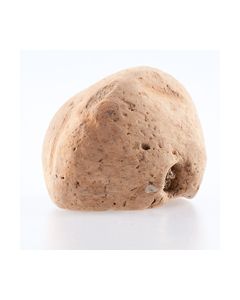 Römisches Gewicht aus Terrakotta
Römisches Gewicht aus TerrakottaTongewicht mit Bohrloch aus römischer Zeit. Provinz Belgica.
Price: on request Römisches Gewicht aus Terrakotta
Römisches Gewicht aus TerrakottaTongewicht mit Bohrlich aus römischer Zeit. Provinz Belgica.
Price: on request Roman swastika brooch
Roman swastika broochThe swastika shape was known to the Romans as crux gammata. This brooch type of the later Imperial period was used in large parts of the Roman Empire.
Price: on request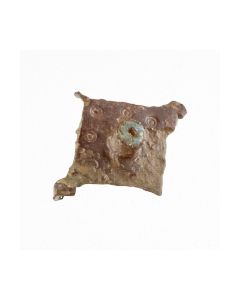 Roman fibula from the Richard Hattatt collection
Roman fibula from the Richard Hattatt collectionLozenge-shaped ancient roman fibula. The piece is published in the standard work "Iron Age and Roman Brooches". Found in Britain.
Price: on request Rare discus-shaped Celtic-Roman fibula
Rare discus-shaped Celtic-Roman fibulaAus der Entstehungszeit der plattenförmigen Fibeln, 1. Jh. n. Chr. Ästhetisch ansprechende Metallarbeit aus einer Fusion keltischer Handwerkstraditionen mit römischen Vorlieben.
Price: on request Rare plate brooch with millefiori enamel
Rare plate brooch with millefiori enamelBrooch from Roman Imperial time, found in Roman Britain. It is an extremely rare and interesting type. The brooch is published in Richard Hattatt's standard work "Ancient Brooches and Other Artefacts" and discussed in detail.
Price: on request Bird shaped Roman brooch
Bird shaped Roman broochProduct of Northern Europe dating to the second century AD. Brooch worked as a flat relief, once with multi-coloured inlays.
Price: on request Roman discus fibula with color glass paste
Roman discus fibula with color glass pasteSpannende Fibel mit Sterndekor und Glaspaste. Eine Weiterentwicklung keltischen Kunsthandwerks in der Zeit römischer Herrschaft. Gut dokumentierter Typ aus dem 2. Jh. v. Chr. mit Verbreitung in weiten Teilen Europas.
Price: on request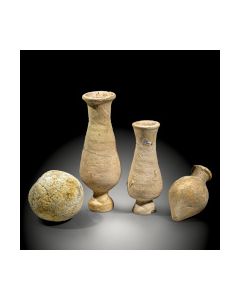 Three Roman pottery amphora plugs and one stone projectile from the Rhineland
Three Roman pottery amphora plugs and one stone projectile from the RhinelandFound 1966 till 1981 near the Roman city of Novaesium, today's Neuss in Germany. Novaesium was an early Roman foundation and with this is one of the oldest cities in Germany.
Price: on request Roman jar from Lopodunum
Roman jar from LopodunumPerfectly preserved piece from the 1st - early 2nd century AD. Found in Ladenburg, Baden-Wuerttemberg, Germany.
Price: on request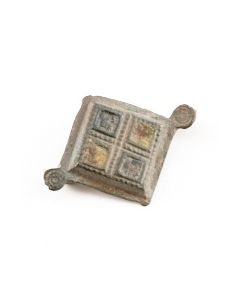 Impressively preserved enameled Roman brooch
Impressively preserved enameled Roman broochIn Britannien und Gallien produzierter Fibeltyp des zweiten Jahrhunderts. Edel patinierte Bronzeoberfläche. Besonders hervorzuheben ist die Emailauflage in selten gutem Erhaltungszustand.
Price: on request Two Roman jugs from the Rhineland
Two Roman jugs from the RhinelandFound 1966 till 1981 near the Roman city of Novaesium, today's Neuss in Germany. Novaesium was an early Roman foundation and with this is one of the oldest cities in Germany.
Price: on request Two small Roman pots from the Rhineland
Two small Roman pots from the RhinelandTwo small Roman pots from the Rhineland
Price: on request Roman jar or beaker, probably found in Trier area.
Roman jar or beaker, probably found in Trier area.Interesting piece from a German collection.
Price: on request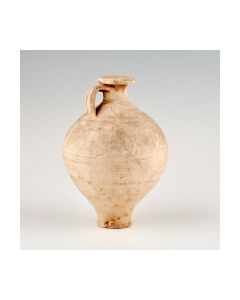 Large Roman jar from Lopodunum
Large Roman jar from LopodunumPerfectly preserved piece from the second half of the 2nd century AD. Found in Ladenburg, Baden-Wuerttemberg, Germany.
Price: on request Roman jar with flat handle
Roman jar with flat handlePerfectly preserved piece from a very old German collection.
Price: on request Zwei antike Bronzebeschläge
Zwei antike BronzebeschlägePaar römische Beschläge, möglicherweise für eine Truhe. Beide mit aufwendigem Dekor, Reste einer Kette bzw. kunstvolles Relief. Museal erhaltene Bronzeartefakte.
Price: on request Roman fibula from the Richard Hattatt collection
Roman fibula from the Richard Hattatt collectionLozenge-shaped ancient roman fibula. The piece is published in the standard work "Iron Age and Roman Brooches". Found in Norfolk, England.
Price: on request Published Roman fibula with celtic design
Published Roman fibula with celtic designAncient fibula from the Roman province of Britain. The design can be attributed to the celtic tribe of the Trinovantes or Iceni. From the famous Hattatt collection. Published twice.
Price: on request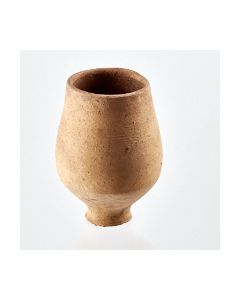 Roman beaker
Roman beakerLarge, nicely preserved piece from a very old German collection.
Price: on request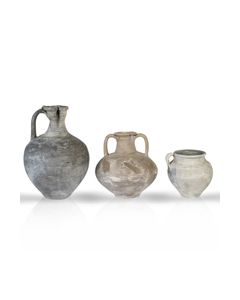 Three Roman pottery vessels from the Rhineland
Three Roman pottery vessels from the RhinelandFound 1966 till 1981 near the Roman city of Novaesium, today's Neuss in Germany. Novaesium was an early Roman foundation and with this is one of the oldest cities in Germany.
Price: on request Three Roman pottery vessels from the Rhineland
Three Roman pottery vessels from the RhinelandFound 1966 till 1981 near the Roman city of Novaesium, today's Neuss in Germany. Novaesium was an early Roman foundation and with this is one of the oldest cities in Germany.
Price: on request Römische Scheibenfibel in Millefiori-Technik
Römische Scheibenfibel in Millefiori-TechnikKunstvolle Fibel aus der Kaiserzeit. Großartiges Beispiel für die antike Millefiori-Technik, die erst wieder in der Neuzeit aufgegriffen und von venezianischen Glaskünstlern zu einer neuen Blüte geführt wurde.
Price: on request Roman fibula with beautiful enamel
Roman fibula with beautiful enamelElaborate work dating to the 2nd century AD. The well preserved enamel is a testimony to the colourful world of ancient art.
Price: on request

